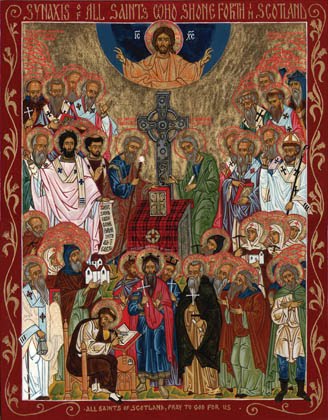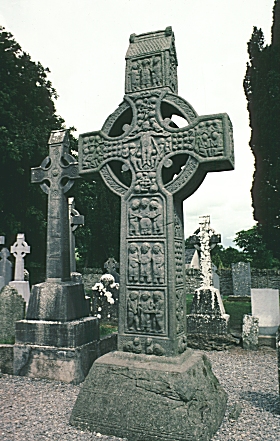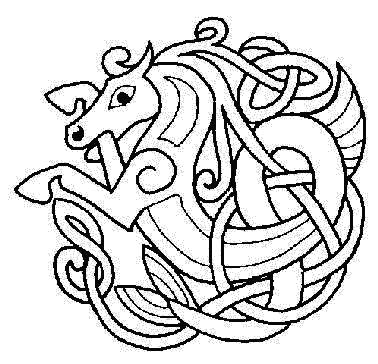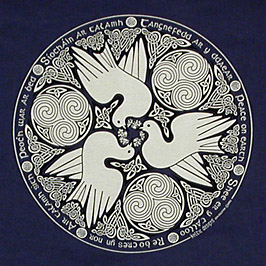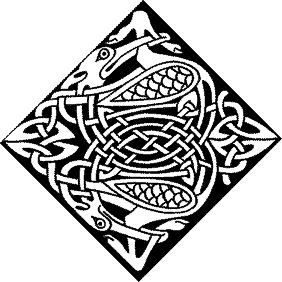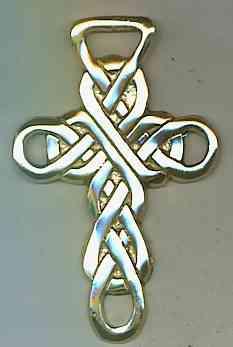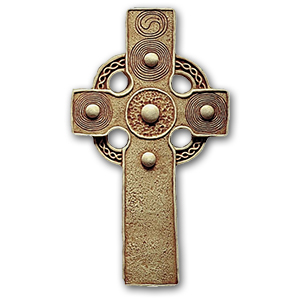
Prayer of St. Columban of Iona
Kindle in our hearts, O God,
The flame of that love which never ceases,
That it may burn in us, giving light to others.
May we shine forever in Thy holy temple,
Set on fire with Thy eternal light,
Even Thy son, Jesus Christ,
Our Savior and Redeemer.
With the imagery of fire and light contained in this wonderful prayer I want to move immediately to a recorded incident in the life of St. Columban, a description which shows how he himself personally experienced this "light" - which of course Orthodox Christians recognize as a vision of the Uncreated Light spoken of in Scripture and in the Holy Fathers. Here is the account:
"One winter's night a monk named Virgnous, burning with the love of God, entered the church alone to pray. The others were asleep. He prayed fervently in a little side chamber attached to the walls of the oratory. After about an hour, the venerable Columban entered the same sacred house. Along with him, at the same time, a golden light came down from the highest heavens and filled that part of the church. Even the separate alcove, where Virgnous was attempting to hide himself as much as he could, was also filled, to his great alarm, with some of the brilliance of that heavenly light. As no one can look directly at or gaze with steady eye on the summer sun in its midday splendor, so Virgnous could not at all bear the heavenly brightness he saw because the brilliant and unspeakable radiance overpowered his sight. This brother, in fact, was so terrified by the splendor, almost as dreadful as lightning, that no strength remained in him. Finally, after a short prayer, St. Columban left the church. The next day he sent for Virgnous, who was very much alarmed, and spoke to him these consoling words: 'You are crying to good purpose, my child, for last night you were very pleasing in the sight of God by keeping your eyes fixed on the ground when you were overwhelmed with fear at the brightness. If you had not done that, son, the bright light would have blinded your eyes. You must never, however, disclose this great manifestation of light while I live.'" It's no wonder, then, that ancient writers said that, on the faces of Celtic monks who had advanced in spiritual life, there rested the glow of caeleste lumen, heavenly light."
In the life of St. Adomnan we read about the following incident:
"At another time when the holy man was living in the island of Hinba, the Grace of the Holy Spirit was poured out upon him abundantly and in an incomparable manner, and continued marvelously for the space of three days, so that for three days and as many nights, remaining with a house barred, and filled with heavenly light, he allowed no one to go to him, and he neither ate nor drank. From that house streams of immeasurable brightness were visible in the night, escaping through chinks of the door leaves, and through the key-holes. And spiritual songs, unheard before, were heard being sung by him. Moreover, as he afterwards admitted in the presence of a very few men, he saw, openly revealed, many of the secret things that have been hidden since before the world began. Also everything that in the Sacred Scriptures is dark and most difficult became plain, and was shown more clearly than the day to the eyes of his purest heart. And he lamented that his foster-son Baithene was not there, who if he had chance to be present during those three days, would have written down from the mouth of the blessed man very many mysteries, both of past ages and of ages still to come, mysteries unknown to other men..."
(Fr. Gorazd Vorpatrny, "Celts and Orthodoxy,"http://www.orthodoxireland.com/history/celtsandorthodoxy/view )
In the Introduction to his translation of the Vita Patrum: The Life of the Fathers, the Righteous Fr. Seraphim of Platina wrote appreciatively about the Orthodox saints of the pre-schism West in Gaul, but of course he could have been writing about the Celtic saints of the British Isles from exactly the same period of time.
"A touchstone of true Orthodoxy," Fr. Seraphim wrote, "is the love for Christ's saints. From the earliest Christian centuries the Church has celebrated her saints-first the Apostles and martyrs who died for Christ, then the desert-dwellers who crucified themselves for the love of Christ, and the hierarchs and shepherds who gave their lives for the salvation of their flocks.
From the beginning the Church has treasured the written Lives of these her saints and has celebrated their memory in her Divine services. These two sources -the Lives and services- are extremely important to us today for the preservation of the authentic Orthodox tradition of faith and piety. The false 'enlightenment' of our modern age is so all-pervasive that it draws many Orthodox Christians into its puffed up 'wisdom,' and without their even knowing it they are taken away from the true spirit of Orthodox and left only with the shell of Orthodox rites, formulas, and customs....To have a seminary education, even to have the 'right views' about Orthodox history and theology-is not enough. A typical modern 'Orthodox' education produces, more often than not, merely Orthodox rationalists capable of debating intellectual positions with Catholic and Protestant rationalists, but lacking the true spirit and feeling of Orthodoxy. This spirit and feeling are communicated most effectively in the Lives of saints and in similar sources which speak less of the outward side of correct dogma and rite than of the essential inward side of proper Orthodox attitude, spirit, piety."
With this principle in mind-that the lives of the saints are of critical importance if we are to understand and pass on true Orthodox Christianity to the next generation-I want to continue by defining two important terms: "Celtic" (or "Celt") and "spirituality."
It may come as a surprise to learn that the Celts actually never called themselves "Celts." This word comes from the Greek Keltos, and means something like "the other" or "a stranger." The Greeks also called these people Keltoi, which was a word the Celts did adopt because it means "the hidden ones" or the "hidden people." In fact, the Old Irish word ceilid means "to hide or conceal." So these people were called "Celts" by those who came into contact with them and saw them as being quite different than other tribes and peoples. And they were. In their long, preChristian period they were a ferocious war-loving lot who fought just for the sheer joy of fighting. "One Roman writer described Celtic men as 'terrible from the sternness of their eyes, very quarrelsome, and of great pride and insolence'. Nor, to his dismay, did these qualities stop with the men. 'A whole troop of foreigners [he wrote] would not be able to withstand a single one if he called to his assistance his wife, who is usually very strong.' The Greek historian Strabo was more blunt in his assessment. 'The whole race,' he concluded, 'is war mad.'"
(No author given; Heroes of the Dawn: Celtic Myth)
Christianity softened all of this, but Celtic Christians did not lose their fierceness which, under the influence of Christ, no longer expressed itself in a lust for war, but now was channelled into Christianity as a way of life - and this they pursued with a singlemindedness rarely seen elsewhere. "Monasticism appeared attractive to a warrior people who were drawn to an ascetic lifestyle. It appealed to a marginalized people who saw the monk as one who lived on the edge of things, on the very margins of life." (Timothy Joyce, Celtic Christianity)We see this in the lives of monks like St. Cuthbert and St. Guthlac, who "were uncompromising solitaries and their ascetic practices aroused wonder...To go all-out for something" is a distinctive mark of Celtic Christians. (Benedicta Ward, High King of Heaven) Another example is in the life of St. Columban who, we are told, "leaped over his mother's grieving body, which was draped across her threshold, in order to head for a monastery.” (Lisa M. Bitel, "Ascetic Superstars,"
www.christianitytoday.com/ch/60h/60h022.html).
It is perhaps not surprising then, to learn that the brave stories of the valiant and heroic King Arthur (who was an actual person) originated among the Celts and were only later picked up and modified and expanded by medieval troubadours and scribes elsewhere in Europe. These included tales of the Round Table and the noble Quest for the Holy Grail, as well as accounts of Arthur's spiritual father, Merlin (who, by the way, was most probably a Celtic bishop named Ambrosius Merlinus, after St. Ambrose of Milan, and not a Druid priest, as used to be thought).
As an aside, may I say that Celtic hermit life "was no walk through a nature reserve or stay at a holiday camp. The hermit had deliberately chosen to live at the limits of existence, a human person containing both heaven and earth."(Ward, op.cit.) Speaking of his own hermit days, St. Cuthbert testified that the demons constantly "cast me down headlong from my high rock; how many times have they hurled stones at me as if to kill me. But though they sought to frighten me away by one phantasmal temptation or another, and attempted to drive me from this place of combat, nevertheless they were unable in any way to mar my body by injury or my mind by fear." (Quoted in Ward, Ibid.)
This account is amazingly close to the temptations suffered by St. Antony the Great in the Egyptian desert. But this is not surprising, because their Christianity - which is to say, their monastic life - was primarily influenced by and formed by the Christian monasticism of the Egyptian desert, and only incidentally from the continent of Europe. This means that Celtic Christians were more like the Byzantine or Slavic Orthodox Christians than Latin or Northern European Christians.
Early this last summer I had an appointment with a new diabetic specialist. Dr. Jennings was very intrigued and pleased to meet "a real live monk", "But," he said, "you don't look like a monk." I said, "What do you mean, I don't 'look like a monk'? I have a beard and wear a black habit." He replied, "Well, you have to realize, Father, that my only images of monks have been formed by television commercials-where the monks are all wearing brown robes, are clean-shaven, have a bald spot in the center of their heads, and are advertising either 'Beano' or computers." I'm afraid this really is the popular image of monks in our culture, today. Most of these images are based upon stereotypical ideas drawn from medieval Western monasticism and applied to both Celtic and Orthodox Christian monastics: it's assumed that we all look like Francis of Assisi, and live in great stone monasteries with cloisters. But this is not an accurate image of Celtic. Rather, Celtic monastic communities were more a relatively modest 'monastic village' than a huge complex of buildings. The village had a stone wall around it to keep animals in and thieves out. Within the walls were many small huts, whether wooden buildings or crude structures of mud and wattle. Later, especially in the west of Ireland, stone buildings were erected. Remains of many "stone clochans, called 'beehive huts' in English, are scattered over the countryside....There is no indication that any large church buildings were ever built...." (Timothy Joyce, Celtic Christianity)
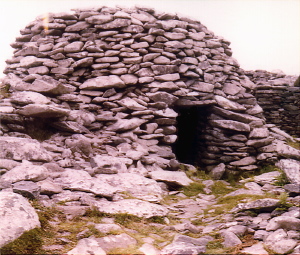 Stone clochan, Ireland
Stone clochan, Ireland
"Other monks and nuns lived out their days alone....in small wood-and-mud huts; they kept a cow or two, and accepted gladly the gifts of an occasional loaf or basket of vegetables from local farmers. The desire for a solitary life and time to spend simply yearning for God...must have drifted through the hearts of even the busiest abbot in the most bustling monastery." (Bitel, op.cit.)
Monastic life was seen as an absolutely essential part of Christian life-the norm for all Christian life, not the exception-, and monks and nuns, hermits and hermitesses were the great heroes of the common people, who saw them, as St. Guthlac put it, as "tried warriors who serve a king who never withholds the reward from those who persist in loving Him." (Quoted in Bitel, Ibid.) Indeed, it is this quality of persistent, even stubborn heroism that particularly stamps the character of Celtic Christianity and, particularly, monastic life - for these were a people whose heroes were monks and nuns, not political leaders or other cultural figures.
St. John Cassian, who is still carefully read and studied by Eastern Orthodox monastics today, was well known to Celtic monks. St. John had spent years as a monk in Bethlehem and Egypt-and recorded his conversations with the Egyptian Fathers--later establishing a monastery near present-day Marseilles, France. The Life of the Egyptian Father, St. Anthony the Great was translated into Latin around the year 380, and we know that this was studied by Celtic monks, who depicted St. Anthony and St. Paul of Thebes on some of the great Irish "High Crosses" (about which I'll say more, shortly).
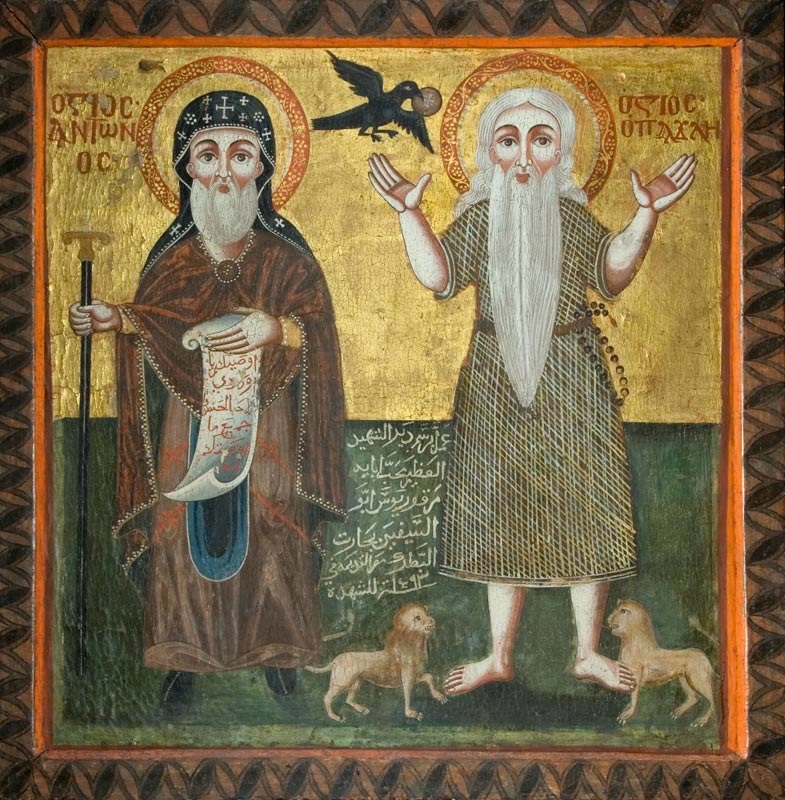
There was phenomenal literacy and very high culture among these monks. In addition, they also learned from the monks of the Egyptian desert how to practice daily "Confession of Thoughts." Their monastic clothing was primarily made from animal skins, so that in appearance they actually resembled St. John the Baptist out in the wilderness - a far cry from the monastics of Europe in their sometimes rather elaborate woven cloth habits.
Now we come to the interesting part: There are records of any number of Christians traveling to the Desert Fathers from the British Isles, and an old Celtic litany of the saints mentions seven Egyptian monks who came to Ireland and died and were buried there. Scholars believe that most of the contact between Ireland and Egypt occurred before the year 640. On an ancient stone near a church in County Cork, Ireland, there is the following inscription: "Pray for Olan, the Egyptian. Also interesting is the fact that even though there are no deserts in the British Isles, the Celts called their monastic communities diserts or "deserts." This was particularly true of island monasteries or hermitages -those spiritual fortresses-- , where the sea itself was like a desert, as an ancient poet said of St. Columban's island hermitage:
"Delightful I think it to be in the bosom of an isle on the peak of a rock, that I might often see there the calm of the sea...That I might see its heavy waves over the glittering ocean as they chant a melody to their Father on their eternal course."
We have a wonderful description of a visit to the monks of Egypt near the close of the fourth century, written by Rufinus of Aquileia. He wrote: "When we came near, they realized that foreign monks were approaching, and at once they swarmed out of their cells like bees. They joyfully hurried to meet us." Rufinus was particularly struck by the solitude and stillness of life among these monks. "This is the utter desert," he observed, "where each monk lives alone in his cell....There is a huge silence and a great peace there." (Quoted in Celtic Saints, Passionate Wanderers, by Elizabeth Rees)
St. David of Wales lived in the 6th century. He came from a monastery which had been founded by a disciple of St. John Cassian. So great is St. David that he deserves a whole lecture to himself, but today I'll just mention him in connection with the wisdom of the Egyptian desert: he possessed the gift of tears, spoke alone with angels, subdued his flesh by plunging himself into ice cold water while reciting all of the Psalms by heart, and spent the day making prostrations and praying. "He also fed a multitude of orphans, wards, widows, needy, sick, feeble, and pilgrims." (Edward C. Sellner, Wisdom of the Celtic Saints)The Roman Catholic scholar, Edward Sellner, adds: " Thus he began; thus he continued; thus he ended his day. He imitated the monks of Egypt and lived a life like theirs." (Ibid.) The same writer assures us that "because of its [the Celtic Church's] love of the desert fathers and mothers, it has a great affinity with the spirituality of the Eastern Orthodox [today]."
There are many other evidences of Eastern and Egyptian contact and influence, too numerous to list now. But in his interesting study, The Egyptian Desert in the Irish Bogs, Fr. Gregory Telepneff mentions also the fascinating interlacing knots and complex designs found on the famous standing High Crosses, which show Egyptian or Coptic influence. "Celtic manuscripts show similarities to the Egyptian use of birds, eagles, lions, and calves....In the Celtic Book of Durrow, one can find not only a utilization of the colors green, yellow, and red, similar to Egyptian usage, but also 'gems with a double cross outline against tightly knotted interlacings,' which recall the 'beginnings of Coptic books.' [Henry, Irish Art]. There is at least one instance of the leather satchel of an Irish missal and the leather satchel of an Ethiopian manuscript of about the same period which "resemble each other so closely that they might be thought to have come from the same workshop' [Warren, Liturgy]." (Telpneff)
Culturally, then, I suggest that Celtic culture was a unique and intriguing blend of Egyptian and other Middle Eastern influences with native or indigenous cultural elements.
Before going further I want to say a few words about the term "spirituality." In our time this has become a wastebasket word into which we put whatever we want the word to mean. Our English word, "spirituality", comes from the French, and originally described someone who was clever, witty, or perhaps even mad! But our ancient Christian ancestors, whether from Russia, Europe, the Middle East, or the lands of the Celts, did not have such a concept. Certainly they did not see spiritual life as something separate from the rest of life. For them, spirituality was how they lived, how they prayed, how they worshiped God-and it was all bound up together, not separated out. Today, however, we have managed to artificially compartmentalize ourselves and our lives, making "spirituality" something that we do in addition to or separate from regular life. This has made possible a very artificial approach to the Celts.
Thomas O"Loughlin, one of the best of our present-day writers on the subject of Celtic Christianity, makes the following sage observation in his book, Journeys on the Edges:
"In the last decade interest in the attitudes and beliefs of the Christians of the Celtic lands in the first millennium has swollen from being a specialist pursuit among medievalists and historians of theology into what is virtually a popular movement. In the process more than a few books have appeared claiming to uncover the soul of this Celtic Christianity in all its beauty....[Many writers] operate by offering their own definitions of 'Christianity' past and present, and then setting these against their definition of 'Celt' or 'Celtic'. In this way they can reach the conclusion they want."
Typical of our modern arrogance and intellectual-spiritual poverty, we project our own feeble ideas back onto a more robust and spiritually rich time, treating the world of Celtic Christianity like a smorgasbord, where we take those things we happen to already "like," and put them together to form our own very distorted and sometimes even perverted "version" of the Celts. An example: It is a fact that in the early Christian centuries, Ireland, Scotland and parts of Wales were never subject to Roman rule-neither the old Roman Empire nor the Church of Rome held sway over "Celts." But some modern writers interpret this to mean that Celtic Christians, since they were "non-Roman," were therefore anti-Roman or even anti-authority and against the idea of an organized, patriarchal Church. There is absolutely no evidence for such a conclusion, although in fact Celtic Christians did have a quite different way of organizing communities than did Christians on the continent-but this was not out of rebellion, but because their own models were from Egypt and the East, not from Europe! The simple fact is that "the Irish church had always been at the edges of Roman Christianity, [and considered to be a] a barbarian church of limited interest to the Popes." (Paul Cavill, Anglo-Saxon Christianity: Exploring the Earliest Roots of Christian Spirituality in England) "Although the climate and situation of Britain were very different from the hot deserts of Egypt, there were principles-simplicity, prayer, fasting, spiritual warfare, wisdom, and evangelism-that were easy to translate to the communities of these isles."(Michael Mitton, The Soul of Celtic Spirituality in the Lives of Its Saints) But this means that entering into the spiritual, mental, emotional, and physical world of a Celtic Christian monk is difficult-not impossible, but difficult.
First we must realize that the Celts had no concept of privacy or individuality such as we have today. Families did not live in separate rooms, but all together; no one thought about the idea of "compartmentalizing space" and only hermits and anchorites felt a calling to be alone in spiritual solitude with God, although monks had separate cells, just as monastics did in the Egyptian Thebaid. The idea that people are separate individuals from the group was not only unheard-of, but would have been considered dangerous, even heretical. Self-absorption, "moods," and being temperamental-all of these things would have been considered abnormal and sinful. It wasn't until the 13th and 14th centuries that people in the West started keeping journals or diaries, and there were no memoirs-also signs of individuality and privacy, of singling oneself out from the family, group, or community-nor were there actual real-life portraits of individuals, until the 14th century. (The art of realistic portraiture developed in response to the medieval idea of romance-for an accurate portrait was a substitute for an absent husband or wife.)
Furthermore, "'the dominant institution of Celtic Christianity was neither the parish church nor the cathedral, but the monastery, which sometimes began as a solitary hermit's cell and often grew to become a combination of commune, retreat house, mission station...school [and, in general] a source not just of spiritual energy but also of hospitality, learning, and cultural enlightenment."(Ian Bradley, quoted in Mitten, Ibid.) It was only much later that people began to be gathered into separate parishes, and even later before bishops had dioceses that were based on geographical lines rather than just being the shepherd of a given tribe or group, "being bishops of a community, rather than ruling areas of land. The idea of 'ruling a diocese' was quite foreign to the Celtic way of thinking." (Ibid.)
If you think about what all of this means in terms of how we today view ourselves, the world in which we live, and the values that we have today, you can see how difficult it's going to be for us to enter into the world of the Celts. Today we are quite obsessive about such things as privacy and individuality, of "being our own selves" and "getting in touch with the inner man" and other such self-centered nonsense. But the Celtic Christian understood, just as did and do Eastern Christians, that man is saved in community; if he goes to hell, he goes alone.
So the orientation of those Christian Celts to God and the other world was very different than the orientation of our modern world, no matter how devout or pious we may be, and this makes the distance between us and the world of Celtic monasticism far greater than just the span of the centuries. A renowned scholar, Sir Samuel Dill, writing generally about Christians in the West at this same period of time, said: "The dim religious life of the early Middle Ages is severed from the modern mind by so wide a gulf, by such a revolution of beliefs that the most cultivated sympathy can only hope to revive in faint imagination ....[for it was] a world of...fervent belief which no modern man can ever fully enter into....It is intensely interesting, even fascinating...[but] between us and the early Middle Ages there is a gulf which the most supple and agile imagination can hardly hope to pass. He who has pondered most deeply over the popular faith of that time will feel most deeply how impossible it is to pierce its secret." (Quoted in "Vita Patrum", Fr. Seraphim Rose)
But is it really "impossible"? To enter their world-the world of Celtic Christianity, which is the same as Celtic monasticism--we must find a way to see things as they did-not as we do today-; to hear, taste, touch, pray, and think as they did. And this is what I mean by the word "spirituality"-a whole world-view. We must examine them in the full context of their actual world-which was a world of Faith, and not just any Faith, but the Christian Faith of Christians in both the Eastern and Western halves of Christendom in the first thousand years after Christ. Spirituality is living, dogmatic, theology. This is the only way we can begin to understand how Celtic Monasticism can be a model of sanctity for us living today, more than a millennium after their world ceased to be. Remember, I said it would be difficult to enter their world; difficult, but not impossible... When we speak of someone or something being a "model," what do we mean? In this instance-speaking about Celtic monasticism as a "model"-we mean something that is a standard of excellence to be imitated. But here I'm not speaking of copying external things about Celtic monasteries-such as architecture, style of chant, monastic habit, etc., which are, after all cultural "accidents." I'm speaking of something inward, of an inner state of being and awareness. It's only in this sense that Celtic monasticism can be, for those who wish it, a "model of sanctity."
But what do I mean by "sanctity"? We must be careful not to slip into some kind of vague, New Age warm "fuzzies" which are more gnostic than Christian and have more to do with being a "nice" person than encountering the Living God in this life. By sanctity I mean what the Church herself means: holiness—which is nothing more or less than imitation of Christ in the virtues, and striving to die to oneself through humility, so as to be more and more alive to Christ, successfully cutting off one's own will in order to have, only the will of Christ, as St. Paul says in his epistle to the Galatians (2:20): "I am crucified with Christ: nevertheless I live; yet not I, but Christ liveth in me... " So, holiness means dying to oneself and especially to one's passions, more and more, so as draw closer and closer to the Lord God Himself, through Jesus Christ, and Him crucified and risen. In addition, Celtic Christians had the concept of "hallowing" or "hallowed"-an old fashioned term that today has survived only in the unfortunate pagan holiday called "Halloween" (from "All Hallows Eve"-which began as the vigil for the Western Feast of All Souls Day and later took on vile pagan overtones). To early British Christians, something or someone that was "hallowed" was "set apart" from others and sanctified for service to God. Thus, a priest's ordination or a monastic's tonsuring was his "hallowing."
And so, thus it was that those blessed and hallowed monastics of Celtic lands modeled forth certain principles that we can still see, study, understand, and imitate today.
The Celts were masters of Christian simplicity. Nowadays there is a movement in our culture to recover some simple basics, but the model is often that of the Quakers or the Shakers or the Amish. Perhaps that's because those groups are easier and more attractive to imitate; I don't know. For the Celts, however, simplicity wasn't so much a question of externals-like furniture, architecture, and so forth. It was something internal, and it was founded upon the Lord's Prayer-in particular the phrase, "Thy will be done", as we find in the later commentaries of the Venerable Bede of Jarrow and Alcuin of the court of Charlemagne. This was crucial to living a simple Christian life: "Thy will be done" meant God's will, not our own--placing absolute trust in the Providence of God for everything-one's health, one's finances, the size of one's family or the size of a monastic community-everything. It meant dying to oneself, not having opinions and not judging others. This was where simplicity began, and from there it easily expressed itself in outward forms, such as not owning five tunics when just two or even one would be sufficient.
Simplicity did not necessarily mean "plainness," as we'll see shortly when we look at the intricate sacred art of the High Crosses. Celtic Christians were not "Plain People," like Quakers or the Amish. But they were "Simple People," in that they were single-minded and intensely focused on the other world and the journey through this life to God.
In common with all Christians at that time, the Celts had no concept of "private prayer" in the sense of spontaneously thinking of words or phrases to say to God. This practice belongs to a much later period in Christian history, when ideas of privacy and individualism had become more important than traditional ways of seeking God through prayer. This didn't mean that a Celtic Christian didn't pray outside the divine services, but for them, prayer was primarily liturgical, and this meant the Psalms. Most monks and nuns memorized the complete Psalter. Occasionally a particularly gifted monk would compose a prayer, such as the one I read by St. Columban at the beginning of this lecture. But in moments of need one remembered verses and phrases from the Psalms -such as "In my distress I cried unto the Lord, and He heard me," from Psalm 120, and "Hide not Thy face from me, O Lord, in the day of my trouble" (Psalm 10, or"In the Lord I put my trust" (Psalm 11).
Central to Celtic Christian culture was the Cross.
Even in the 7th and 8th centuries there were so-called Christians who were uncomfortable with the Cross of Christ and chose to ignore it, just as there are today. The Celts, however, had a particularly clear-headed understanding of the Cross. To quote Sister Benedicta Ward, a renowned scholar on the subject of the Desert Fathers as well as monasticism in the British Isles in the early Christian centuries: "The Cross was not something that made them feel better, nicer, more comfortable, more victorious, more reconciled to tragedy, better able to cope with life and death; it was rather the center of the fire in which they were to be changed." (op.cit.) It reminded them that they must pick up and carry their own crosses in this life and follow Christ, for dying to oneself has always been the great secret of holiness.
Thus, these monks and nuns saw themselves as warriors of the spirit, for to die to oneself was considered a greater act of heroism than dying on a battlefield in defense of one's tribe. "The Celtic Church was a Church of heroes...of strong and fiercely dedicated men and women." "The old Celtic warrior spirit was alive in them, [but now] put to the service of the Gospel and the following of Christ, the High King. Today [we might] find it hard to identify many [such] warrior Christians...[with] the active virtues of courage, strength, outspokenness, decisiveness, and the ability to stand up for something." (Joyce, op.cit.)
Nowhere was the Cross more loved and cherished than in the monasteries, where highly-carved and richly symbolic great "High Crosses"-some of them 15 feet and taller-- were set up-many of them still standing today.
These were not the suffering and bloody crucifixions found later in the West, particularly in Spain and Italy. Nor were these the serene and peaceful crosses of the Eastern Church. No, Celtic crosses were a genuine Christian expression all their own. Sometimes Christ is depicted, but often not; however, when He is shown, He is always erect, wide-eyed, and fully vested like a bishop, a great High Priest. In this form He is a symbol of victory over sin and death; He radiates invincibility.
"The way of the cross for [Celtic Christians] was the way of heroic loyalty, obedience, and suffering. It involved study and thought, doctrine and orthodoxy, art and imagination. It was a complete, unified way of life, lived intimately with God....[Our] fragmented modern world, both secular and religious, has a lot to learn from it." (Cavill, op.cit.)
A common ascetic practice, even for the laity, was called crosfhigheall or "cross-vigil", and it consisted of praying for hours with outstretched arms. St. Coemgen sometimes prayed in this position for days. Once he was so still, for so long, that birds came and began to build a nest in his outstretched hands.
Scholars believe that the Celtic High Cross patterns probably came from Egypt. There are no loose ends in these patterns; this symbolizes the continuity of the Holy Spirit throughout existence-for God has no beginning and no end.
An example of the love and respect they had for the Cross may be seen in an Anglo-Saxon poem, "The Dream of the Rood" ("rood" being an Old English word for "rod" or "pole", sometimes it also meant "gallows"). In the "The Dream of the Rood," Jesus Christ, the Second Person of the Blessed Trinity, is shone as a "serene and confident young hero...[who] prepares for battle. He strips...and climbs up on the gallows [the Tree of the Cross], intent on saving His people. He is in control, self-determining, expressing His lordship [And] the Cross trembles at the fearful embrace of its Lord." (Cavill, op.cit.) Listen, now, as the Cross, personified, speaks of how it raised up Christ:
"Unclothed Himself God Almighty when He would mount the Cross,
courageous in the sight of all men. I bore the powerful King, the Lord of heaven;
I durst not bend. Men mocked us both together. I was bedewed with blood.
Christ was on the Cross. Then I leaned down to the hands of men and
they took God Almighty."
(Ward, Ibid.)
The interlacing, knot-work, plaiting, weaving patterns and spiral designs, with animals and plants and saints, and scenes from Scripture, which decorate almost every surface of a Celtic High Cross, are so distinctive and profound in their symbolism that they are a study all to themselves. Today I can only point out a couple of things.
Scholars believe that these incredibly complex patterns probably came from Egypt, but also may have some Byzantine influences. It's important to note that there are no loose ends in these patterns; this symbolizes the continuity of the Holy Spirit throughout existence - for God has no beginning and no end; only Christ is the Alpha and the Omega. The same is true of knot-work patterns, which are endless and cannot be untied. Spiral designs symbolized the Most High God Himself, the "motionless mover," around whom all things move. Some of these are what are called "Crosses of the Scriptures" because they are decorated with panels illustrating scenes from the Bible. High Crosses possess an almost dream-like quality in their complex geometric patterns, dignified and strong, heroic and towering over men, and yet also reminding those Christians of the Christian doctrine of kenosis, the self-emptying of Christ.
One of main factors contributing to the eventual decline and dissolution of a Celtic monastery was when the Cross began to no longer be a focus. "If monastic life...did not have at its center the reality of the Cross, it became a source of corruption....[for] 'Once a religious house or order cease[d] to direct its sons to the abandonment of all that is not God and cease[d] to show them the narrow way...it [sank] to the level of a purely human institution and whatever its works may be they are the works of time and not of eternity.'" (Dom David Knowles, quoted in Ward, Ibid.)
An essential dimension was asceticism (askesis) which, for the Celtic monk consisted of a kind of martyrdom. "A homily in archaic Irish, probably dating from the last quarter of the seventh century...speaks of [this]: 'Now there are three kinds of martyrdom, which are accounted as a cross to a man, to wit: white martyrdom, green and red martyrdom. White martyrdom consists in a man's abandoning everything he loves for God's sake, though he suffer fasting or labor therat. Green martyrdom consists in this, this, that by means of fasting and labor [a Christian] frees himself from his evil desires, or suffers toil in penance and repentance. Red martyrdom consists in the endurance of a cross or death for Christ's sake, as happened to the Apostles...'...For this reason, the Celtic tradition regarded monasticism as the Army of Christ (Militia Christi) and the monk as a soldier of Christ (miles Christi). Young men, in their effort to emulate the heroism of their ancestors, entered monasteries-the "Green Martyrdom." Instead of fighting in the Fianna (the Celtic army), they joined the Militia Christi to wage war against the evil spirits and sin." (Fr. Gorazd Vorpatrny, op.cit.) Not surprisingly, one writer calls these Celts "Ascetic Superstars." (Bitel, op.cit.)
"I should like a great lake of ale for the King of Kings;
I should like the angels of heaven to be drinking it through time eternal!"
- St. Brigit of Kildare
And yet, with all of this sober asceticism, the Celts never lost their native enthusiasm, exuberance, and just plain cheer, as we see in a prayer written by the wonderful 5th century Abbess, Brigit, when she exclaims: "I should like a great lake of ale for the King of Kings; I should like the angels of heaven to be drinking it through time eternal!" How could anyone fail to be charmed by such a character - a woman who was a great leader of monastics, both men and women, who was baptized by angels, got out of an arranged marriage by plucking out one of her eyeballs, and fell asleep during a sermon given by the incomparable Equal-to-the-Apostles, St. Patrick!
Finally, the Celts were Trinitarian Christians par excellence. This is partly because even before they were Christian they already thought in terms of threes. And for them-unlike most Christians today-the Trinity was very real, very alive, not something vague and theoretical. What one scholar calls a "Trinitarian consciousness" (Joyce, op.cit.) completely shaped everything about them. As another has said: "'We are here at a central insight of Celtic theology....Christ comes not to show up or illuminate the deformity of a fallen world but rather to release a beautiful and holy world from bondage an affirmation, difficult but possible, of [that] which is the created image of the eternal Father and the all-holy Trinity.'" (Noel Dermot O'Donoghue, quoted in Joyce, op.cit.) "To follow the spiritual world-view of the Celtic Christians is to embrace a way of life that is a real commitment to the belief that the Trinitarian God is alive in this world." In the Celtic world, "Jesus Christ is our hero, our sweet friend....The Father is High King of heaven, a gentle and beneficent father, a wise and just ruler. The Spirit is a tangible comforter and protector ....This God is never to be reduced to the 'man upstairs' or anyone we can capture and box in. And yet this wonderful, mysterious God is close to us....[This] God is extremely good." (Ibid.)
Brothers and sisters: the sanctity of Celtic monastics is a model for us in that it combines heroism and joy in perfect and beautiful balance. For them, the heroic life was one completely dedicated to living intimately with the God-Man whom they described as "victorious," "mighty and successful," "the lord of victories," a great warrior to whom they pledged undying, fearless, creative and exuberant loyalty. And yet, for all of their heroism, their monastic world-view, could be 'summed up as the 'Christian ideal in a sweetness which has never been surpassed.'" (Nora Chadwick, quoted by Joyce in op.cit.) To slip into their world, even for just a few moments, as we've done here this afternoon, is, I believe, is not just inspiring; it's almost breathtaking.
Just as I began my talk today with a prayer of St. Columban of Iona, I would like to conclude with another prayer from this great Celtic monastic saint:
Prayer of St. Columban of Iona
Lord, Thou art my island; in Thy bosom I rest.
Thou art the calm of the sea; in that peace I stay.
Thou art the deep waves of the shining ocean. With their eternal sound I sing.
Thou art the song of the birds; in that tune is my joy.
Thou art the smooth white strand of the shore; in Thee is no gloom.
Thou art the breaking of the waves on the rock;
Thy praise is echoed in the swell.
Thou art the Lord of my life;

